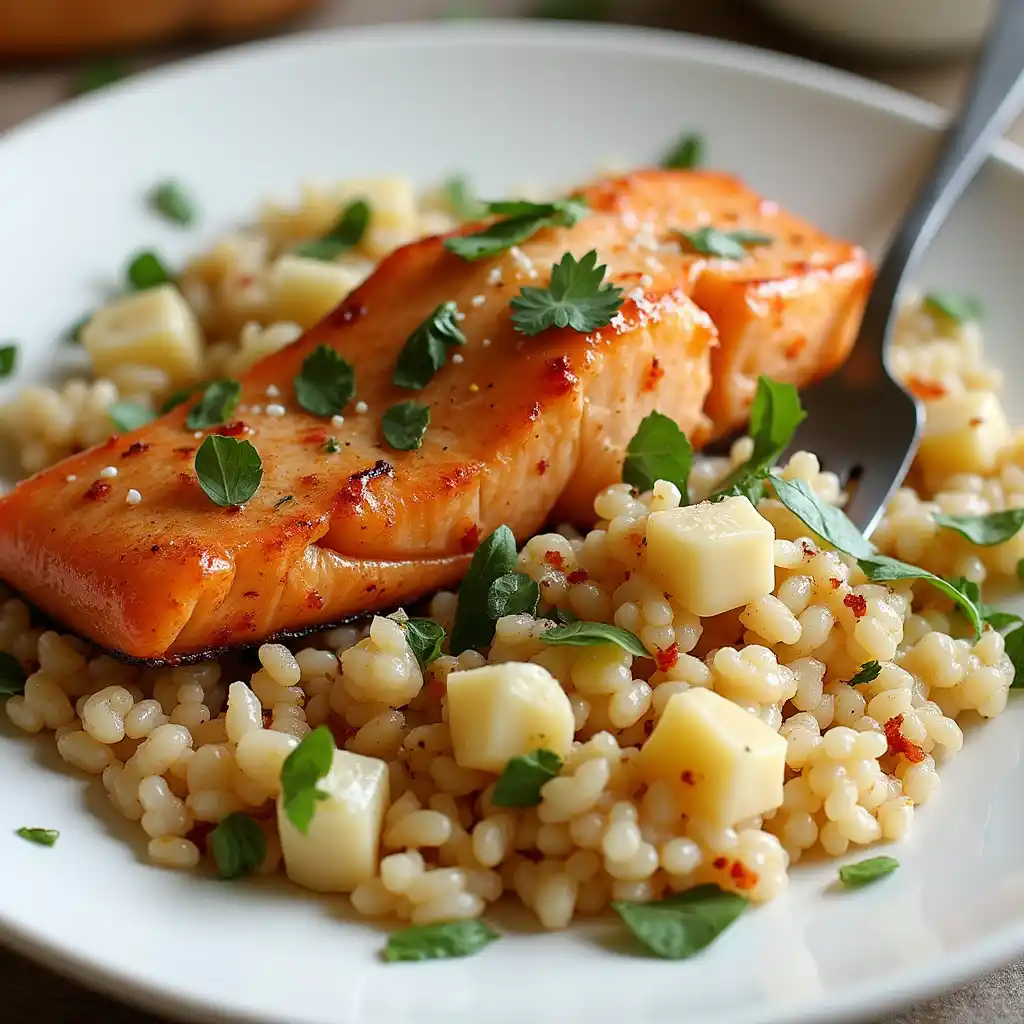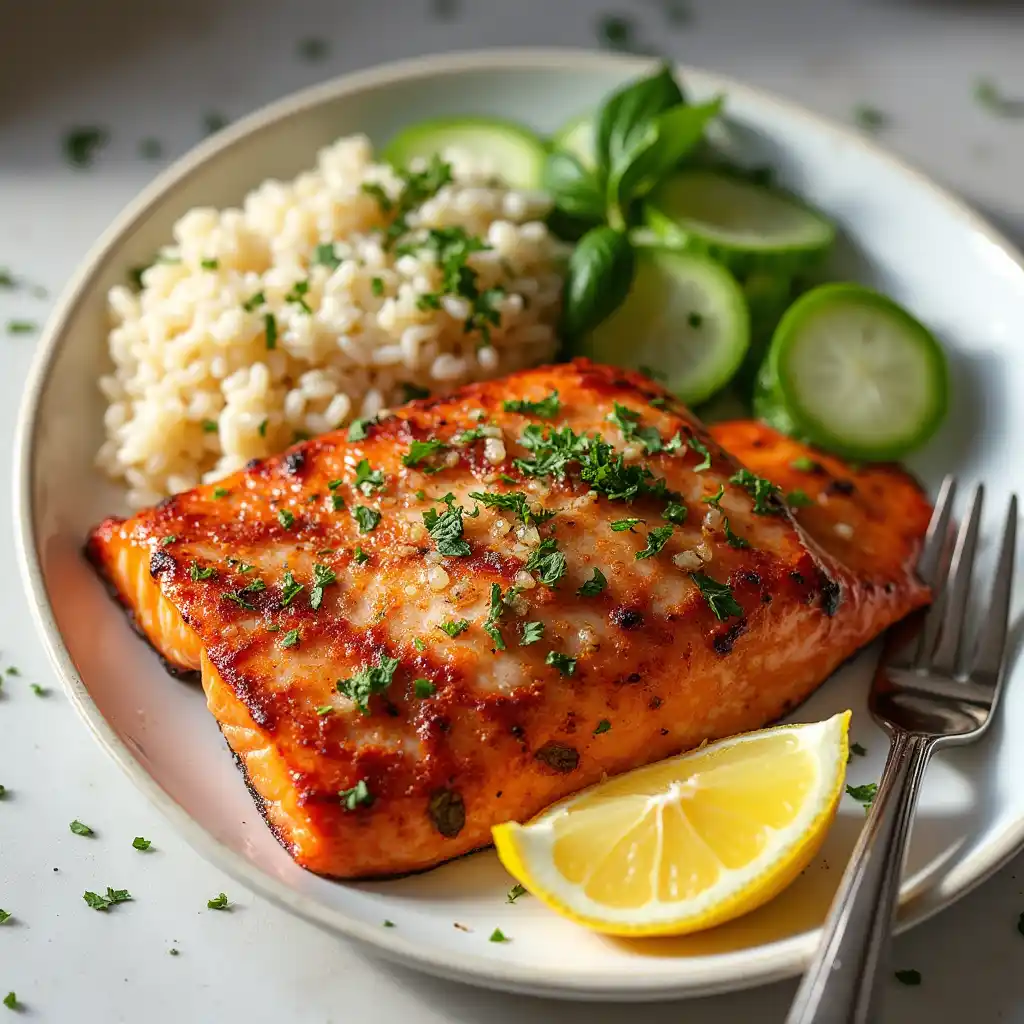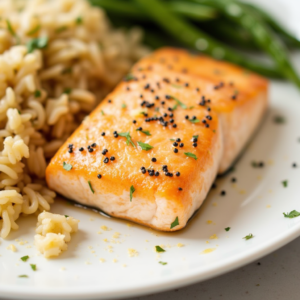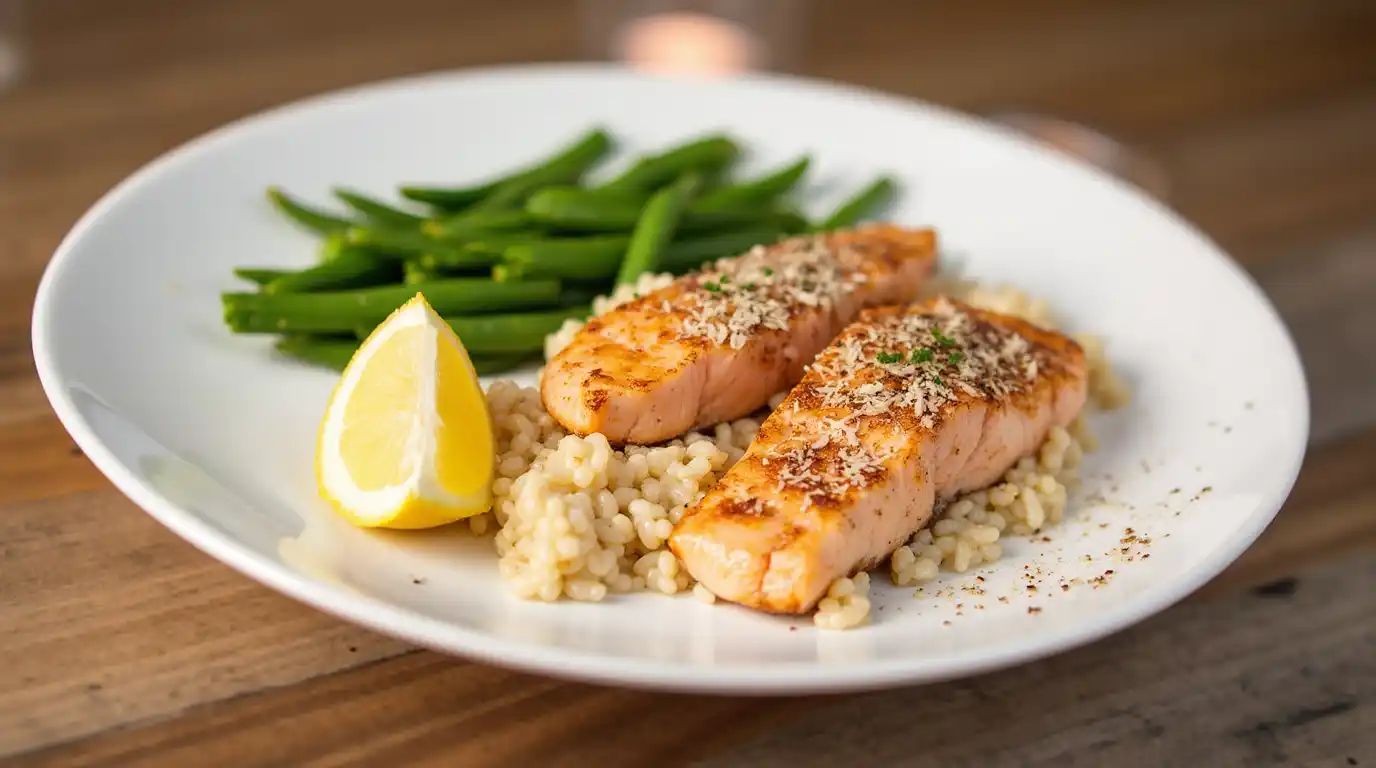When it comes to preparing a simple yet delicious and nutritious meal, salmon and rice are often the go-to choice for many home cooks. This combination is not only easy to make but also offers a wide range of flavors and health benefits. Whether you’re looking for a quick dinner or a meal prep idea for the week, salmon and rice make an excellent pairing. This article will explore the reasons why this duo is perfect for any occasion, as well as provide a detailed guide to cooking it just right.
Why Salmon and Rice Make a Perfect Combination
Salmon and rice are a great duo because they balance each other perfectly in terms of flavor and texture. Salmon, with its rich, tender flesh, complements the mildness of rice, creating a harmonious blend that works well with a variety of seasonings. Whether you’re making a simple dish or getting creative with flavor variations, salmon and rice are versatile enough to fit any culinary style.
- Salmon provides a rich, buttery flavor.
- Rice serves as a neutral base that absorbs the flavors of the salmon.
- The combination is quick, easy, and ideal for busy weeknights.
- Salmon and rice can be adapted to various dietary needs, including gluten-free and low-carb options.
Health Benefits of Salmon
Salmon is known for being a superfood due to its numerous health benefits. Rich in omega-3 fatty acids, it plays an essential role in reducing inflammation and supporting heart health. Additionally, salmon is a great source of protein, which is important for muscle repair and growth.
- Omega-3 fatty acids help lower the risk of heart disease.
- Salmon is packed with vitamins, including vitamin D and B12, which are crucial for bone health and immune function.
- It also contains selenium, an antioxidant that supports thyroid function and overall well-being.
- Salmon is low in calories but high in essential nutrients, making it a perfect choice for a balanced diet.
Nutritional Value of Rice
Rice, particularly brown rice or wild rice, is a healthy staple in many diets. While it may be low in fat, rice is an excellent source of complex carbohydrates, which provide energy over a longer period. Rice is also high in fiber, particularly in whole grain varieties, and contains several essential nutrients like magnesium and iron.
- Rice offers slow-releasing energy, which helps to keep you full longer.
- Brown rice is higher in fiber compared to white rice.
- It is also rich in B vitamins, which aid in metabolism and overall health.
- The neutral flavor of rice makes it a versatile base that pairs well with proteins like salmon.

Ingredients for the Perfect Salmon and Rice
To create the perfect salmon and rice dish, you’ll need a few simple ingredients that highlight the natural flavors of both elements. Here’s a list of essential ingredients for the dish:
- Salmon fillets (fresh or frozen)
- Rice (brown, white, or wild rice)
- Olive oil or butter
- Garlic
- Lemon
- Fresh herbs (such as parsley or dill)
- Salt and pepper
- Optional: Soy sauce or honey for added flavor
These basic ingredients form the foundation of a delicious and nutritious meal.
Fresh Salmon vs Frozen Salmon
One important choice you’ll make when preparing salmon and rice is whether to use fresh or frozen salmon. Both options can yield a tasty meal, but there are key differences to consider:
- Fresh salmon often has a superior taste and texture, especially if sourced sustainably.
- Frozen salmon is more convenient and can be stored for a longer time, making it ideal for meal prep.
- Both fresh and frozen salmon provide the same nutritional value, including omega-3 fatty acids and protein.
Ultimately, the choice between fresh or frozen salmon comes down to your preference and availability.
Types of Rice You Can Use
While salmon and rice is a classic pairing, the type of rice you choose can change the flavor and texture of the dish. Here are some options:
- White rice: A classic, mild option that absorbs flavors well.
- Brown rice: A whole grain option that offers more fiber and a nuttier flavor.
- Wild rice: Nutty and chewy, it adds a unique texture to the dish.
- Jasmine rice: Fragrant and slightly sticky, perfect for an aromatic twist.
- Basmati rice: Long-grain and aromatic, great for a more refined texture.
Each type of rice pairs beautifully with salmon, depending on your preference for flavor and texture.
Step-by-Step Guide to Cooking Salmon and Rice
Now, let’s dive into the process of making a delicious and satisfying salmon and rice meal. Follow these steps for the best results:
How to Prepare the Rice
Preparing the rice is an essential step in making sure your salmon and rice meal is a success. Here’s how:
- Rinse the rice: Start by rinsing your rice under cold water to remove excess starch.
- Cook the rice: Use a ratio of 1 cup of rice to 2 cups of water (or as directed on the package). Bring it to a boil, then reduce the heat and cover. Let it simmer for 15-20 minutes (for white rice), or longer for brown or wild rice.
- Fluff the rice: After cooking, fluff the rice with a fork to separate the grains.
How to Cook the Salmon
Cooking the salmon is simple, but timing is key to achieving the perfect texture.
- Prepare the salmon: Season your salmon with salt, pepper, and any desired spices.
- Pan-sear or bake: Heat olive oil or butter in a skillet over medium heat. Cook the salmon for about 4-5 minutes per side, depending on thickness, or bake it in a preheated oven at 375°F for 12-15 minutes.
- Check doneness: Salmon should flake easily with a fork and be opaque throughout.
Combining Salmon and Rice
Once both the salmon and rice are cooked, it’s time to combine them. Serve the rice as a base, topping it with the perfectly cooked salmon. Garnish with fresh herbs like dill or parsley and a squeeze of lemon juice for added freshness.
Flavor Variations for Your Salmon and Rice
To elevate your salmon and rice meal, consider these flavor variations that can add depth and excitement to your dish.
Adding a Zesty Lemon Butter Sauce
A lemon butter sauce is a simple yet delicious way to enhance the flavor of your salmon and rice. Just melt butter in a saucepan, add fresh lemon juice, garlic, and a pinch of salt. Drizzle it over the cooked salmon for a rich, citrusy finish.
Teriyaki Glazed Salmon Option
For a sweet and savory twist, try a teriyaki glaze for your salmon. Simply brush the salmon fillets with teriyaki sauce before baking or grilling. This adds a caramelized, umami flavor that pairs beautifully with the mild taste of rice.
Spicy Cajun Salmon Rice
If you enjoy a bit of heat, a spicy Cajun salmon rice is a fantastic option. Season your salmon with Cajun spices before cooking, and add a little hot sauce to the rice. This fiery combination is sure to satisfy those who enjoy bold flavors.

Cooking Time and Temperature for Salmon
Achieving the right texture for your salmon is all about perfect timing. Typically, salmon should be cooked at 375°F for 12-15 minutes, or until it reaches an internal temperature of 145°F. The flesh should be opaque and flake easily with a fork. Keep in mind that thicker cuts may require a bit more time.
Achieving the Right Texture in Rice
The texture of rice is crucial to making a balanced salmon and rice dish. Whether you prefer fluffy rice or a more sticky texture, here are a few tips:
- For fluffy rice, use the correct water-to-rice ratio and avoid stirring the rice while it cooks.
- For sticky rice, reduce the water slightly, allowing the grains to hold together.
- Always fluff the rice after cooking to prevent it from becoming too dense.
By following these tips, you’ll achieve the perfect texture in your rice, complementing the richness of the salmon.
Storing and Reheating Salmon and Rice
When preparing a meal with salmon and rice, it’s important to store leftovers properly to maintain the flavor and texture. Whether you’re making extra for meal prep or simply want to save some for later, following the right storage and reheating techniques will help preserve the quality of the dish.
How to Store Leftovers
To store leftover salmon and rice, follow these simple steps:
- Cool the meal quickly: Allow the salmon and rice to cool at room temperature for no more than 2 hours.
- Use airtight containers: Store the leftovers in airtight containers to prevent them from drying out or absorbing other odors.
- Refrigerate promptly: Place the containers in the refrigerator. Salmon and rice can last for 2-3 days in the fridge if stored properly.
Make sure to label the containers with the date to keep track of freshness.
Reheating Techniques for Best Results
When reheating salmon and rice, the goal is to preserve the texture and flavor of the meal. Here are the best techniques:
- Oven method: Preheat your oven to 350°F. Place the salmon and rice in an oven-safe dish, cover with foil to retain moisture, and heat for 10-15 minutes.
- Microwave method: Cover the leftovers with a damp paper towel to retain moisture, then microwave in 30-second intervals, stirring between.
- Skillet method: For a crispy texture on the salmon, heat the dish in a skillet over medium heat for a few minutes, stirring the rice occasionally.
These methods will help ensure your salmon and rice remain just as delicious as when freshly cooked.
Pairing Ideas to Enhance Your Meal
Pairing salmon and rice with complementary sides and drinks can elevate the flavor of the dish. Here are a few ideas to enhance your meal and take it to the next level.
Best Vegetables to Serve with Salmon and Rice
Vegetables not only provide balance and color to your plate but also add extra nutrients to your salmon and rice meal. Consider these options:
- Asparagus: A light, crunchy vegetable that complements the richness of salmon.
- Broccoli: A nutritious and hearty choice that adds texture and flavor.
- Spinach: Fresh, tender greens that pair well with the delicate flavors of salmon and rice.
- Green beans: A simple and classic vegetable that adds a slight crispness to your meal.
These vegetables not only enhance the flavor of your dish but also contribute to a well-rounded, nutritious meal.

What Drinks to Pair with Salmon and Rice
When it comes to pairing drinks with salmon and rice, you want something that complements the flavors without overpowering them. Here are some great drink options:
- White wine: A crisp Sauvignon Blanc or Chardonnay can enhance the richness of salmon while keeping the dish light.
- Sparkling water: The effervescence helps cleanse the palate between bites, balancing the textures of salmon and rice.
- Iced tea: A refreshing, slightly sweetened iced tea pairs nicely with the mild flavors of the dish.
- Lemonade: The citrusy tang of lemonade adds a bright contrast to the savory elements of the meal.
These drinks will enhance the dining experience, making your salmon and rice meal even more enjoyable.
How to Make This Recipe Your Own
One of the best things about salmon and rice is how versatile it is. You can customize the dish to suit your personal preferences by adjusting the rice, adding different vegetables, or experimenting with flavors. Here’s how to make this recipe uniquely yours.
Customizing the Rice
The type of rice you use can dramatically change the flavor and texture of your salmon and rice meal. Consider these options to switch things up:
- Brown rice: A heartier option that adds more fiber and a nutty flavor to the dish.
- Jasmine rice: Fragrant rice that pairs wonderfully with the delicate taste of salmon.
- Quinoa: For a gluten-free alternative, quinoa adds a slightly nutty flavor and extra protein.
- Cauliflower rice: A low-carb substitute that works well for those following a keto or paleo diet.
Each type of rice will bring a unique element to your salmon and rice dish, allowing you to tailor it to your dietary needs and flavor preferences.
Adding Vegetables to the Dish
You can easily add vegetables to your salmon and rice to create a more filling and colorful meal. Try incorporating the following:
- Peas: Sweet peas add a burst of color and a mild flavor that complements the salmon.
- Carrots: Shredded or sliced carrots add a sweet crunch and vibrant color to the dish.
- Zucchini: Sautéed zucchini is a great option that brings a light, fresh element to the meal.
- Bell peppers: Chopped bell peppers provide sweetness and a slight crunch that pairs perfectly with both salmon and rice.
Adding vegetables not only enhances the nutrition of your meal but also adds depth of flavor and texture to your salmon and rice dish.
FAQs on Salmon and Rice
Here are some frequently asked questions about salmon and rice, along with helpful answers to ensure your meal turns out perfectly every time.
Can I use other fish besides salmon?
Yes, you can absolutely use other fish in place of salmon in this recipe. Some great alternatives include:
- Trout: A milder-flavored fish that still provides the rich texture similar to salmon.
- Tilapia: A light, flaky fish that cooks quickly and pairs well with rice.
- Cod: Another mild fish that offers a tender, flaky texture when cooked.
- Halibut: A slightly firmer fish with a clean, subtle taste.
While salmon is known for its richness and healthy fats, these alternatives can still work well in a salmon and rice dish, offering unique flavors and textures.
How do I know when the salmon is fully cooked?
To ensure your salmon and rice is perfectly cooked, follow these tips:
- Check the internal temperature: Use a meat thermometer to check that the internal temperature of the salmon has reached 145°F.
- Flake the fish: Gently insert a fork into the thickest part of the fish. If it flakes easily and appears opaque, it’s fully cooked.
- Look for color changes: The salmon will change from a translucent pink to a more opaque hue as it cooks.
By following these methods, you can ensure that your salmon is cooked to perfection and pairs wonderfully with the rice.
Can I make this dish in advance?
Yes, you can make salmon and rice in advance. Here are a few tips for preparing the dish ahead of time:
- Cook the rice: Rice can be cooked in advance and stored in an airtight container in the fridge for up to 4-5 days.
- Prepare the salmon: While salmon is best cooked fresh, you can prep it by seasoning it and refrigerating it until you’re ready to cook.
- Store separately: If possible, store the rice and salmon separately to prevent them from becoming soggy.
Reheat the salmon and rice using the methods mentioned earlier for optimal results.
Is this recipe suitable for meal prep?
Absolutely! Salmon and rice are both meal-prep-friendly. The dish can be prepared in large batches and stored for several days in the fridge. For meal prep:
- Store in individual containers: Portion out the rice and salmon into separate meal prep containers.
- Keep the rice separate: To prevent sogginess, store the rice in a separate compartment or container from the salmon.
- Reheat properly: Follow the best reheating techniques to maintain flavor and texture.
This makes salmon and rice a perfect option for busy weeknights or healthy lunches.
Can I use brown rice instead of white rice?
Yes, brown rice is a great substitute for white rice in your salmon and rice dish. Brown rice provides additional fiber and a nuttier flavor, making it a healthier option. However, it does require a longer cooking time, so make sure to adjust your cooking method accordingly. Here are a few tips:
- Increase cooking time: Brown rice typically takes about 45 minutes to cook, compared to 15-20 minutes for white rice.
- Use more water: Brown rice needs more water than white rice to cook properly—about 2 cups of water per 1 cup of rice.
Swapping to brown rice will add a different texture and boost the nutritional value of your dish.
What’s the best way to season the salmon?
The seasoning you use can elevate the flavor of your salmon and rice dish. Here are some seasoning options for perfect salmon:
- Lemon and garlic: A simple combination of lemon zest, fresh garlic, and a touch of olive oil brings out the freshness of the fish.
- Dill and mustard: A classic flavor pairing for salmon, adding tanginess and freshness.
- Herb blend: Try a mix of thyme, rosemary, and parsley for a fragrant, savory experience.
- Cajun spices: For a bit of heat, season with Cajun spices for a flavorful, slightly spicy kick.
Experimenting with different seasonings will help you find the perfect flavor profile for your salmon and rice meal.
Conclusion
In conclusion, salmon and rice is a versatile and nutritious dish that can be customized to suit your preferences. Whether you’re using fresh or frozen salmon, experimenting with different types of rice, or adding your own seasonings and vegetables, the possibilities are endless. By following the simple steps provided for storing, reheating, and enhancing your dish, you can enjoy a delicious, well-rounded meal every time.
Remember, with the right preparation and seasoning, salmon and rice can be tailored to your tastes and dietary needs. So, get creative, and enjoy the satisfying combination of flavors and textures!

Salmon and Rice
Ingredients
- 4 salmon fillets
- 1 cup rice
- 2 tbsp olive oil
- 1 lemon sliced
- 2 cloves garlic minced
- Salt and pepper to taste
- Fresh herbs optional for garnish
- Pros:
- Quick and easy to prepare
- High in protein and omega-3
- Healthy and nutritious
- Great for meal prep
- Cons:
- May not be suitable for those with seafood allergies
- Can be dry if overcooked
Instructions
- Preheat oven to 400°F (200°C).
- Cook the rice according to package instructions.
- Season the salmon fillets with olive oil, salt, pepper, and minced garlic.
- Place the salmon fillets on a baking sheet and top with lemon slices.
- Bake for 15-20 minutes until salmon is cooked through and flakes easily with a fork.
- Serve the salmon on top of the rice and garnish with fresh herbs if desired.
Notes
- For extra flavor, marinate the salmon in olive oil, garlic, and lemon juice for 30 minutes before baking.
- You can substitute the rice with quinoa or couscous for a different texture.
- Adjust the seasoning to taste, especially with herbs like dill or parsley for added freshness.
- Make sure not to overcook the salmon; it should be flaky and tender but still moist.
- This recipe pairs well with a side of steamed vegetables or a fresh salad for a balanced meal.


